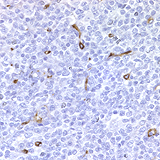
|
Microvessel Density and Expression of Vascular Endothelial Growth Factor and Its Receptors in Diffuse Large B-Cell Lymphoma Subtypes
Dita Gratzinger,
Shuchun Zhao,
Robert J Marinelli,
Amy V Kapp,
Robert J Tibshirani,
Anne S Hammer,
Stephen Hamilton-Dutoit,
Yasodha Natkunam
|
|
|
|
|
Home
|
-
Welcome to the web
supplement to the paper:
Microvessel Density and Expression of Vascular Endothelial Growth Factor and Its Receptors in Diffuse Large B-Cell Lymphoma Subtypes
Am J Pathol. 2007 Apr;170(4):1362-1369.
-
Abstract:
Angiogenesis is known to play a major role in neoplasia, including hematolymphoid neoplasia. We assessed the relationships among angiogenesis and expression of vascular endothelial growth factor and its receptors in the context of clinically and biologically relevant subtypes of diffuse large B-cell lymphoma using immunohistochemical evaluation of tissue microarrays. We found that diffuse large B-cell lymphoma specimens showing higher local vascular endothelial growth factor expression showed correspondingly higher microvessel density, implying that lymphoma cells induce local tumor angiogenesis. In addition, local vascular endothelial growth factor expression was higher in those specimens showing higher expression of the receptors of the growth factor, suggesting an autocrine growth-promoting feedback loop. The germinal center-like and nongerminal center-like subtypes of diffuse large B-cell lymphoma were biologically and prognostically distinct. Interestingly, only in the more clinically aggressive nongerminal center-like subtype were microvessel densities significantly higher in specimens showing higher vascular endothelial growth factor expression; the same was true for the finding of higher vascular endothelial growth factor receptor-1 expression in conjunction with higher vascular endothelial growth factor expression. These differences may have important implications for the responsiveness of the two diffuse large B-cell lymphoma subtypes to anti-vascular endothelial growth factor and anti-angiogenic therapies.
|
|
|
|
[ Home
| Tissue Images
| WebPortal
| Authors
]
|